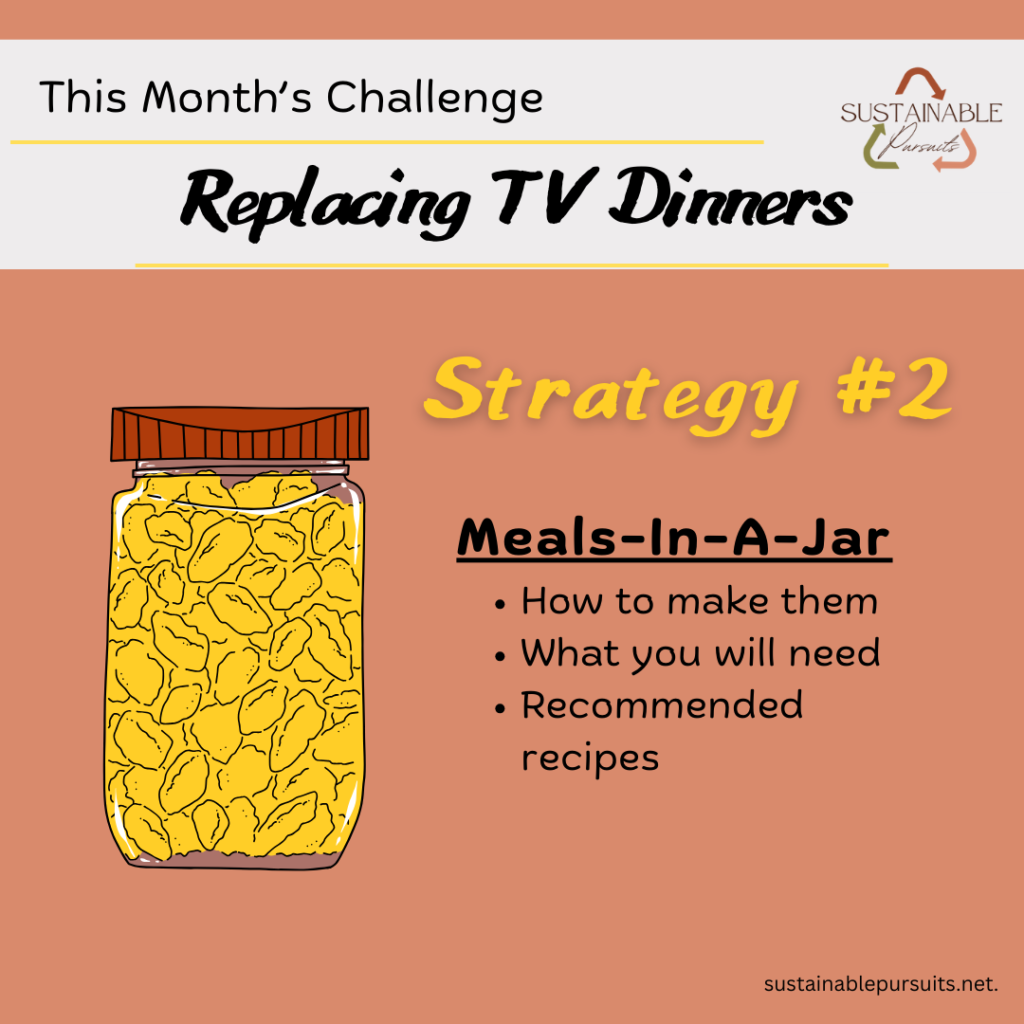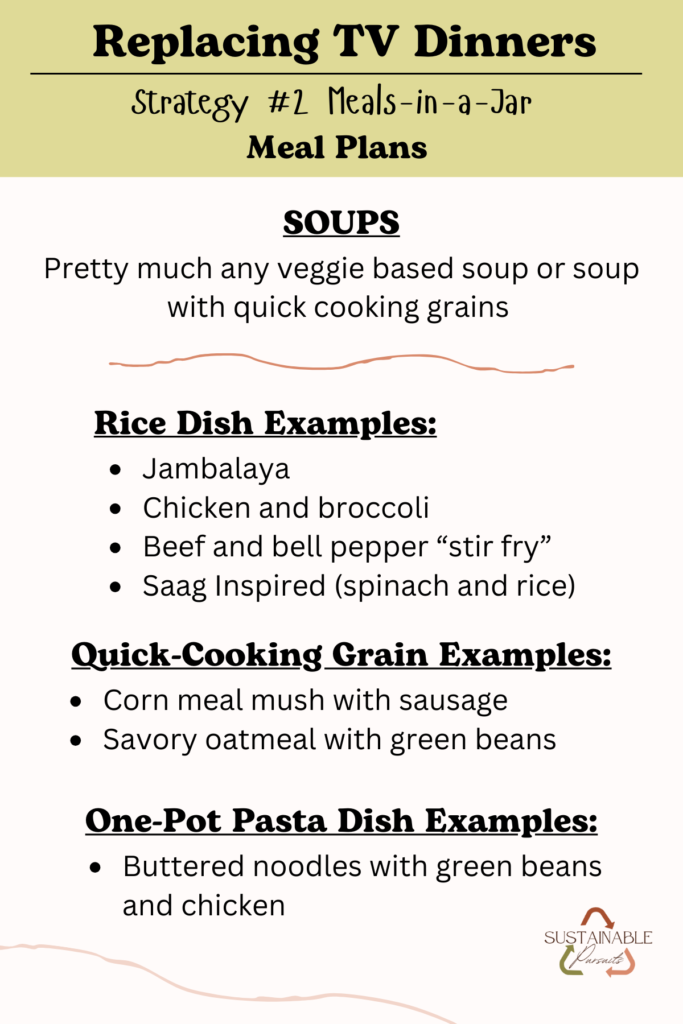
This month’s eco-friendly challenge is replacing TV dinners with plastic-free alternatives. We have 3 strategies to help us achieve this goal. Last week, the focus was on the freezer meal strategy. This week we’re going to delve into the second strategy using meals-in-a-jar as the replacement.
What are meals-in-a-jar?
Meals-in-a-jar (aka mason jar meals) are when dried ingredients are assembled in a container, usually a jar, to be rehydrated later. The benefit of these meals is that they don’t need cold storage. All the ingredients are low moisture and shelf-stable so they can be stored at room temp. You can use dehydrated or freeze-dried ingredients for the jar meals, just know that the cooking times will be longer for dehydrated foods.
A lot of regular recipes can be converted to meals-in-a-jar but it might take some trial and error before you get the recipe just right. A mason jar meal cookbook is a really good place to start for this strategy and to find recipes. But more importantly, the books usually have a section where they cover best practices in more detail than I am for this article.
Which should you use: freeze-dried or dehydrated foods?
I prefer freeze-dried foods because they rehydrate much quicker and have a better texture than most dehydrated foods. This is because freeze-dried foods and dehydrated foods are dried using entirely different processes. I already covered some of those processing differences in my freeze-dried food article so I won’t go into detail here.
I use the freeze-dried foods from Thrive Life Foods because I personally like their variety and quality of the food. They have freeze-dried fruits, veggies, meats, mushrooms, cheeses, and more! Because of their variety I can easily recreate my favorite recipes for meals-in-a-jar. Since I get so much use out of their foods, I became a Thrive Life consultant earlier this year. If you would like to learn more about Thrive Life freeze-dried foods, please feel free to use my link*.
Just a quick note – when I’m talking about dehydrated foods, I don’t mean things like pasta, rice, barley, etc. I’m referring mostly to produce items like fruits, vegetables, and meats.
Using Meals-in-a-Jar to Replace TV dinners
Needs to cook quickly
These are just my own parameters, but I feel like a good TV dinner replacement shouldn’t take much longer than 15 minutes to heat/cook. Unfortunately, there are quite a few meals-in-a-jar recipes that take longer than 15 minutes to cook. Usually 30 minutes to an hour. Don’t get me wrong, these recipes are still great and I use them all the time for my easy to assembly dinners…
…but I prefer the just-add-water meals that only need to cook for about 15 minutes. My go-to is usually soups but there are other recipes too. The soups can be either veggie-based, like a vegetable beef soup, or grain-based, like chicken and rice soup. The other type of recipes I like to use, or convert, are the one-pot-meals.
Can be cooked all at once
A lot of the meals-in-a-jar recipes I come across will separate the ingredients because they need to be cooked separately. Again, nothing wrong with this, but I want to keep things as simple as possible for a TV dinner replacement. Also, the recommended way to store the ingredients separately is in a plastic bag inside the jar, and I haven’t figured out a good alternative for this…maybe beeswax wrap or parchment paper?

Which grains to use
As a note, instant/quick cooking grains and pasta usually cook in about 15-20 minutes. I use instant/quick cooking grains not only because they cook quicker but they don’t have to be rinsed before cooking. Many grains, and red lentils, do cook quickly enough to meet the criteria but need to be rinsed first. This makes it difficult unless you’re storing the grains separately.
A few exceptions
I do make a few exceptions to my ‘all in one jar’ rule. Exceptions like butter, which I usually have on hand when I’m at home. Or foods that can be easily added during cooking, like a can of tomato sauce, a jar of Alfredo, or a can of beans. I just make sure to store the additional ingredient right next to the meal-in-a-jar. It’s nice to have all the meal ingredients in one place especially when you’re in a hurry.
Storing meals-in-a-jar
Note: this storage information is from Thrive Life freeze-dried foods* and is based on their products.
Most freeze-dried foods can be stored up to 25 years, some things like eggs and butter have a shorter shelf life of about 8 years. Once the can is opened, the food can continue to be stored for a few months to a year. If you would like more information about storing freeze-dried foods, please read Thrive Life’s flyer on shelf life. I don’t work much with dehydrated foods, so if you’re using them my best advice is to follow the storage instructions on the packaging.
I usually go through my jar meals in about a month or two, and I’m in a dry climate, so I’ve never really worried about the additional storage procedures for my dry food. But if you’re going to be storing the jar meals for longer periods, or you’re in a more humid climate, you should probably consider them. They involve using oxygen/moisture absorbers (I found a pattern to make your own!) and a jar vacuum sealer for your food storage.
Recommended Books and Resources:
Meals-in-a-jar are a great way to replace TV dinners! Check out these resources for more tips and inspiration for getting started with this week’s strategy and having easy quick meals in your food storage.
- Good and Cheap* by Leanne Brown – (This is the cookbook I use for my Jambalaya and Savory Oats recipe)
- Thrive Life website recipe section
- Meals In A Jar Made Easy by Jodi Weiss Schroeder – (recipes specifically using Thrive Life foods. You may need to do a bit of conversion if you are using another freeze-dried food companies products)
- A Year Without the Grocery Store* by Karen Morris – (food storage and meal in a jar recipes)
If you use Pinterest you might be interested in my curated board regarding this month’s 3 strategies to ‘Replace TV dinners’.
*I will only recommend products that I personally use and love and hope can be of benefit to others in their sustainable journeys. (*) indicates an affiliate link where Sustainable Pursuits llc may receive a small compensation for product recommendations. This helps to support Sustainable Pursuits llc and my ability to share these experiences with you!

